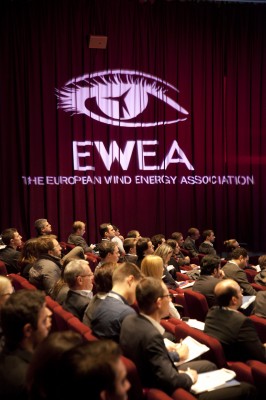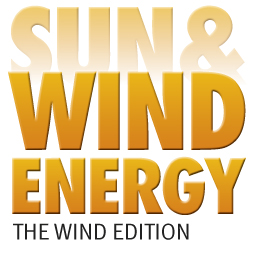Poster presentations

Proceedings: all participants have been given the link to the page from which they can download all presentations.
Proceedings are also available free of charge to all EWEA members via the EWEA Members’ Area.
For non-EWEA members, proceedings can be ordered on this page.
| Carl Robert Brand Research Assistant Universität Hannover (confirmed) |
Flaps for wind turbine applications: Initial results of acoustic experiments |
| Harald Debertshäuser PhD Student DTU Wind (confirmed) |
Modeling of low frequency noise from wind turbines |
| Iva Hrgovan PhD Student DTU (confirmed) |
Design of efficient and low noise wind turbine blades |
| Martina Repossi Project developer Alerion Clean Power S.p.A. (confirmed) |
Italian guidelines about wind turbine sound: how to improve them and make them work better. |
| Kendall Rutledge Project Leader Novia University of Applied Sciences (confirmed) |
Spatial distribution of acoustic modulation depth around a modern wind turbine |
| Lars Sommer Søndergaard Specialist DELTA (confirmed) |
Noise from wind turbines at other wind speeds than 6 and 8 m/s |
| Wei Jun Zhu Senior researcher DTU Wind Energy (confirmed) |
Development and comparisons of wind turbine noise propagation models |
Abstracts
Flaps for wind turbine applications: Initial results of acoustic experiments
Poster presenter: Carl Robert Brand, Research Assistant, Institute of Turbomachinery and Fluid Dynamics, Universität Hannover
Abstract: Unsteady wind conditions and the atmospheric shear layer produce high dynamic loads on wind turbine rotors during operation. These high loads can lead to long-term failure in blades and to a non-reparable breakdown of the entire wind turbine. Rotors extended with trailing edge flaps have great potential to reduce these critical loads. However, experimental investigations of airfoils with flaps in aviation applications show a significantly higher global sound emission. Specifically, the turbulent, unsteady flow around the side edge of the flap causes additional sound sources, emitting noise in low and high frequency ranges.
Consequently, these additional sound sources can also emerge when using flaps on wind turbine rotors. Hence, extra sound sources would add to well known wind turbine noise sources such as trailing edge noise. Higher noise emissions may be noticed by residents of nearby areas. As the power of wind turbine noise is a key driver for their acceptability, further social conflicts may occur.
Thus, the acoustic properties of an airfoil with trailing edge flap for wind turbine applications are experimentally investigated in the frame of the joint project Smart Blades. The experimental investigations are performed in an open jet wind tunnel at the Institute of Turbomachinery and Fluid Dynamics of Leibniz Universität Hannover and in an acoustic wind tunnel of the German Aerospace Center. The global noise emission of the test airfoil is recorded by microphones at different positions downstream. The presumed sound sources at the flap are localized by an acoustic camera and beamforming algorithm. With this method, the main source positions and frequency ranges can be identified. First results of these investigations will be presented.
Design of efficient and low noise wind turbine blades
Poster presenter: Iva Hrgovan, PhD student, DTU Wind
Abstract: To avoid losses in annual energy production (AEP) due to noise curtailment, wind turbines should be designed to emit as low noise as possible. In general, noise can be decreased to some extent by using airfoils with reduced self-noise, but the blades should be completely redesigned to maximize the noise reduction.
We propose a holistic approach that comprises aero-elastic and aero-acoustic model to optimize and design low noise blades. The aero-elastic response is calculated using a structural dynamics code (coupled) including a blade element momentum theory. Aerodynamic noise emitted from wind turbine rotors is estimated using a modified Brooks-Pope-Marcolini model and the optimization is performed with a gradient-based solver. The optimization objective is to minimize the cost of energy while reducing the noise emission and keeping the AEP on the level of a wind turbine in full power (without curtailment). In the design of low noise blades, the new low noise DTU-LN2xx series designed at DTU is used.
Initial results indicate a greater noise reduction when the turbine rotor is optimized as a whole system instead of optimizing on a component level.
Modeling of low frequency noise from wind turbines
Poster presenter: Harald Debertshäuser, PhD student, DTU Wind
Abstract: Aeroacoustic noise from wind turbines may be a cause of annoyance from people living in the
neighborhood of the turbines. This may cause problems with respect to public acceptance of wind
turbines and hamper the further development of wind power. To ensure a continuous development of wind power, it is therefore required to develop techniques for modeling and reducing wind turbine noise [2].
Noise restrictions on wind turbines became stricter over time in Denmark so that noise prediction becomes more and more important. Additionally special restrictions for low frequency noise have been added to the Danish legislation on wind turbines [5]. Hence low frequencies noise prediction is of great interest for new multi-MW turbines.
For wind turbines there are different effects that influence low frequency noise:
• Up-scaling effect
• Inflow Turbulence
• Wake effects
• Amplitude modulated noise
The main objective of the first part of the PhD project is to couple the in-house flow-acoustic splitting technique [1-2] with the in-house Navier-Stokes Actuator Line technique [3-4]. As the flow-acoustic splitting technique basically requires the detailed flow solution in the boundary layer to form the acoustic source, it is often used with large eddy simulation (LES) or direct numerical simulations (DNS) which requires too much computing time for wind turbine flows. On the other hand the actuator line technique with LES and atmospheric turbulence, where the loading of wind turbines is introduced as a body force along lines which representing wind turbine blades, was developed to focus on the wake development behind wind turbines.
The presentation will summarize the used methods and first results of blade noise and turbulent inflow noise of a NM80 wind turbine will be shown.
Italian guidelines about wind turbine sound: how to improve them and make them work better.
Poster presenter: Martina Repossi, Project Developer, Alerion Clean Power S.p.A.
Abstract: Wind turbines can produce unwanted sound (referred to as noise) during operation. The nature of sound depends on wind turbine design. Sound propagation is primarily a function of distance, but it can also be affected by turbine placement, surrounding terrain, and atmospheric conditions. In Italy, unlike in other European countries, there is no specific legislation about wind turbine sound measurement and noise limits from Law no.447 are not functional for noise verifical for wind farms. Public health is an essential Constitutional right (art.32 from Italian Constitution: “la Repubblica tutela la salute come fondamentale diritto dell’individuo e interesse della collettività”) and disagreements related to wind farms noise are actually recurring. In January 2012, “Massachusetts Department of Environmental Protection. Turbine Health Impact Study: Report of Independent Expert Panel” reported that there is insufficient epidemiologic evidence to determine whether there is an association between noise from wind turbines and annoyance independent from the effects of seeing a wind turbine and vice versa. Anyway, although investigators may not know the exact nature of the relationship between noise and health impacts, environmental noise pollution can have serious implications for public health. Energy companies are properly requested to monitor the effects of wind turbine noise and preserve people from having consequences due to this aspects. To reach this significant goal, some authorities (i.e. ISPRA “Istituto Superiore per la Protezione e la Ricerca Ambientale“) are elaborating studies in order to define methods for measuring wind turbine noise. When more information and studies become available, best practices can be developed and adopted. Moreover, wind turbine noise control systems are improving, so we can reduce their noise impacts on the surroundings. That’s why we would need to create a standardized system both for developers and inhabitants in order to make them live together and solve reciprocal problems without controversy.
Spatial distribution of acoustic modulation depth around a modern wind turbine
Poster presenter: Kendall Rutledge, Project Leader, Novia University of Applied Sciences
Abstract: Modulation depth has been cited as an important factor associated with human annoyance of wind turbine noise. In this research we model the ground plane associated modulation depth character surrounding a modern wind turbine using a modified version of the National Renewable Energy Laboratory’s (NREL) FAST/NOISE modules. The modifications to the noise modules permit the capture of the predicted time dependent acoustic spectra using the aero-acoustic source mechanisms described by Brooks, Pope and Marcolini and by Amiet. The modifications also allow input and subsequent predictions for an arbitrarily sized and positioned locus of points defining observer locations. The FAST method estimates the wind turbine full system structural dynamics which allows an accurate determination of the aerodynamic environment of the airfoil segments which are used to represent each blade. This aerodynamic knowledge serves as input into the noise source models. The turbulent wind environment for forcing the aero-mechanical system was derived from optimizing local parameters for input into the NREL Turbsim model. We present comparisons of acoustic model results and validation observations from arrays of microphones to serve as a measure of the validity of the method. A method for auralizing non-tonal broadband third-octave time-series will be used in the presentation.
Authors: Kendall Rutledge1, Petri Välisuo2, Tuomas Haapa-Aho3, and Dennis Bengs1
(1) Novia University of Applied Sciences, (2) University of Vaasa, (3) Mervento Ltd, Vaasa, Finland
Noise from wind turbines at other wind speeds than 6 and 8 m/s
Poster presenter: Lars Sommer Søndergaard, Specialist, Acoustics, DELTA
Abstract: Modern wind turbines become more and more advanced with many settings so it is possible to optimize the wind turbine(s) according to the actual site in order to produce the most power. In Denmark noise from wind turbines are regulated at 6 and 8 m/s relative to 10 m height and there is a concern in the communities that modern wind turbines can and will be “noise optimized” to emit relatively less noise at the two regulated wind speeds. DELTA has investigated this issue for the Danish EPA .
DELTA has since the 80’s performed a high number of measurements of noise from wind turbines recently primarily according to IEC 61400-11 and the Danish Statutory orders 1284 and 1518, which in terms of sound power level are comparable. For this investigation modern Danish wind turbines and noise measurements has been the focus for a wider wind speed range than 6 and 8 m/s. 74 measurements days on 6 different wind turbines has been chosen for further analysis. The 6 wind turbine types represent the most common types recently erected in Denmark.
Following data analysis no minima for the emitted sound power at 6 or 8 m/s is seen – neither for wind turbines running in a noise reduced mode or for non-noise reduced wind turbines. In general data shows that the noise from the wind turbines raises with wind speed up to approximately 7 m /s, after which the noise at higher wind speeds, are either constant or slightly decreasing. Comparing noise reduced wind turbines and non-noise reduced wind turbines for very low and high wind speeds the analysis is however based on few data.




Follow EWEA on: